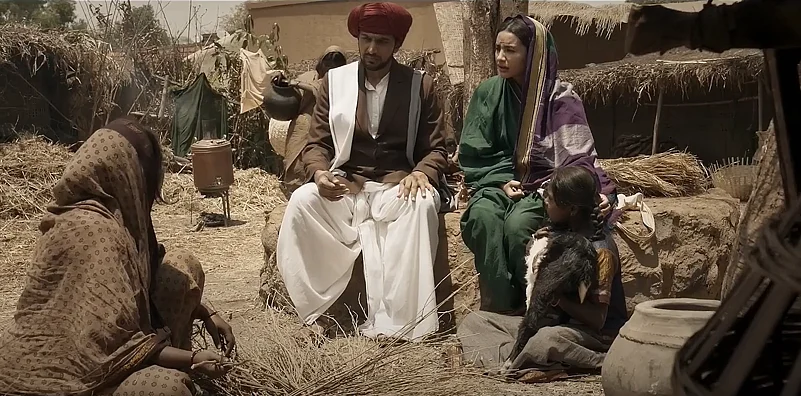One must read A Gardener in the Wasteland if Anant Mahadevan라이브 바카라 Phule, released this Friday to much furore, spikes interest. Written by Srividya Natarajan and illustrated by Aparajita Ninan, the graphic novel can be read in about an hour and serves as a more searing and thought-provoking critique of the caste system and Brahmanical Hinduism through the figures of Jyotiba and Savitribai Phule. Like the book, the film Phule also draws from the writings of Jyotirao Phule, primarily Gulamgiri, while stating in its disclaimer that it results from “extensive research.” Perhaps this “extensive research” is why the film appears informational and staged, but rarely cinematic. The cuts often work like pauses for a scene-change in a play rather than a weave of movement; the camera lacks dynamism which, if present, would have made the Phules come alive on screen.
But the show was packed, and people clapped at all the right moments. A mother with her son beside me declared the film to be good as the credits rolled. The spectators evidently enjoyed the experience, and I wondered what the reason was. The film라이브 바카라 biggest draw is the historical and political significance of Phules’ work in democratising education, encouraging rational thinking, opening ashrams for widows, fighting against caste-based discrimination, and challenging the hierarchical organisation of society. This weight of history, it seems, makes audiences turn a blind eye to how their story is told and focus on what their story is about. It is one thing to introduce Jyotiba라이브 바카라 rational polemics against religious orthodoxy, and another to thoroughly engage with his thought to expose the faultlines of Brahmanical Hinduism. The latter is the undercurrent of Phule라이브 바카라 ideas; the grandness of his legacy does not lie solely in facts, but in the vastness of his consciousness.

Therefore, the scene in the film where his shadow falls directly at the footsteps of a group of Brahmins crossing his path is deeply satisfying. As the Brahmins fluster at the prospect of his shadow touching them, Jyotiba (Pratik Gandhi) walks straight toward them; they quickly retreat, he charges onward, and they continue to withdraw until pushed to the edge of the frame. By reversing the customary prey-predator power relations, the visual charisma of this short scene mirrors a lion라이브 바카라 prowl as the shadow becomes both a weapon and a shield to wage war against the body of the Brahmanical order.
If the film had sustained this aesthetic language, where Jyotiba라이브 바카라 presence was both a site of power and tension, rather than merely imparting knowledge like a textbook, it would have stayed with spectators long after they left the theatre. Caste system, in the final analysis, retains power through beliefs in myths, by posturing religious ostracisation of people as a divine order of existence, and by controlling and conditioning the sensory and visceral practices of a society. When the battle of purity and pollution unfolds at the site of touch, a film라이브 바카라 incapacity to generate feeling and stir the body into experiencing a myriad of emotions —anger, frustration, melancholy, hope, vulnerability, courage, power, oppression, and revolt—represents an overwhelming shortcoming.

One must also ask—are aesthetics backed by massive production costs only reserved for Bajiraos, Shivajis, Ratan Singhs, Tanajis, and Gandhis of the world? But, be the financial structure as it may, Dalit filmmakers like Pa Ranjith and Nagraj Manjule have repeatedly provided us with a working schema to reclaim epic forms of cinematic storytelling. Borrowing from them should not be seen as artistic weakness or appropriation; rather, neglecting to look in their direction for inspiration gestures a return towards conservatism. In the contemporary world, those in the margins and footnotes of history can save the fate of grand and monumental forms of storytelling. Epics have traditionally sung the songs of kings and queens, repeatedly siding with brutality, imperialism, and the structural supremacy of one group over another. Thus, they have become anachronistic today; the dethronement of this form has signaled an aesthetic revitalisation.
Barring a few tableaus in Phule, the political potential of a subverted epic form remains largely under-utilised. The film appears flat because it limits itself to historical facts, playing it safe while hesitating to foreground the corporeality of the anti-caste movement and how the Phules’ struggles resonate with present-day India. The dangerous and thus radical potential of such a film lies in making the experience of caste oppression so immediate that one struggles to dissociate from its manufactured suffering, while also preventing the privileged caste from claiming that pain as their own, through cinematic transference of feeling. Even though the film does not fetishise the Phules’ struggles, it does isolate and safely tuck away their experiences of discrimination, hardship, and rebellion in a bygone era.
Savitribai (Patralekhaa) finds more space in this biopic, gaining confidence and courage over the course of the film. Her electrifying slap to a man threatening her and Jyotiba was met with urgent applause in the theatre. While we learn about her contributions to the empowerment of girls and women, we do not gain insight into her psychic life, as if her body is exclusively social, untethered from a private subjectivity. When she says to Yashwant, her adopted son, in the climax, “I hope your story is better than ours,” one is overcome with sadness because Jyotiba and Savitribai라이브 바카라 sacrifice, exhaustion, grief, and tragedy in tandem with the beauty of their revolution and love for each other is wasted in Anant Mahadevan라이브 바카라 Phule.
Srishti Walia is a doctoral student of Cinema Studies at the School of Arts and Aesthetics, Jawaharlal Nehru University, New Delhi.















